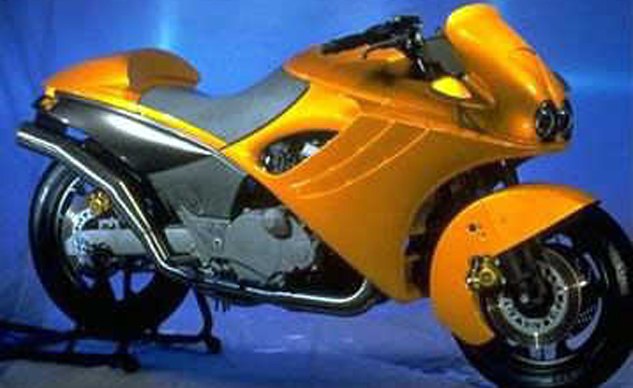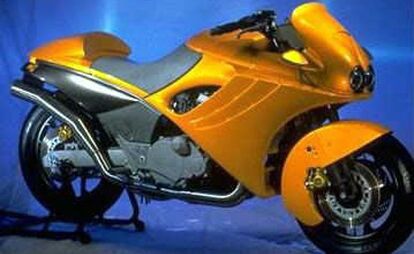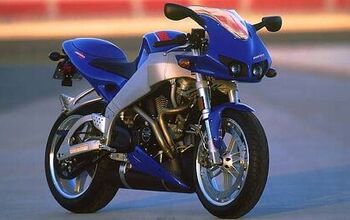Church Of MO – MachineArt MK9

Let’s face it: in 1996 Japanese sport tourers may have been premium performers, but they really weren’t very attractive. Especially when put side-by-side with their Italian counterparts. Andrew Serbinski set out to change that, one Kawasaki GPz1100 at a time. His creation, the MachineArt MK9, is what happens when an industrial designer gets his hands on clay (these were the days before CAD software, remember), to make a Japanese motorcycle easy on the eyes. In this week’s Church of MO, we pay a visit to Serbinski and his masterpiece. MachineArt is still in existence today, though Serbinski never did create a second example.
MachineArt MK9
Grace and Beauty From New Jersey –For $10,000, Would You Buy One?
Now don’t get us wrong, we like Kawasakis. But unlike our opening trio of Italian supermodels, a search for high style among the Japanese Big Four will leave you hard pressed to find unique, inspired design. For example, the Suzuki GSX-R750 recently established solid leadership in sportbike value and performance, but it didn’t exactly make its way to the top with irresistible beauty. Sorry GSX-R owners, but we think most people would agree that the Gixxer’s visual design is no competition for the suave Ducati 916. Why is that? Maybe because the Suzuki is so much cheaper?
As proof he created the MachineArt MK9, a completely road worthy and street-legal concept bike that demonstrates what Kawasaki’s competent but uninspiring GPz1100 could have been. Intrigued, we arranged to meet up with Serbinski at his home in rural New Jersey to talk about the current state of affairs in motorcycle design, and to get the first test-ride of his latest creation.
It’s obvious that Serbinski is frustrated with the status quo from Japan. “Motorcycles that have lots of personality,” claims Serbinski, “like Ducatis, were the vision of one or a few people rather than a committee — which is how the Japanese ones are (typically) designed. When the Japanese do a new product, they gather competitive product pictures together and put them in a kind of a matrix of styles to evaluate. The problem is they’re using existing products to capture visual information, and if they’re designing something new they shouldn’t base it solely on what exists now because it’s already old stuff. They should be challenging existing norms and thinking of other ways to interpret what the design ought to be. (Instead) they’re all watching each other very closely.”
Of course, it’s one thing to promise such a transformation, but quite another to actually deliver a bike that can outclass the best results of a Japanese design team. But when Serbinski rolled the MK9 out into the clear light of afternoon, all hype became reality. I wanted it immediately!
Finally it was our chance to discover first-hand what it’s like to ride the MK9, which up to this point had never been pried from the designer’s loving hands. Your first impression is that the MK9 feels fat in the waist, splitting your legs apart like a wishbone. Combined with a wider-than-normal turning radius, this can turn low speed maneuvering into a chore. But once underway the impression of width is completely replaced by a sense of comfort, with lots of room to move around.
I was pleased to find that the body was good for more than just first-class posing, being surprisingly effective at directing wind around the rider despite the short, rakish windscreen. We cruised on backroads at speeds up to 70 mph with little more than a breeze reaching the cockpit. With no wind tunnel testing in the picture, Serbinski admitted that he simply designed it to look good and got lucky with the aerodynamics.
That’s a shame really, because we think an excellent case can be made that motorcycle design can move smartly into the future without losing its traditional appeal. As you read this, Serbinski and company are considering alternatives for bringing the MK9 style to the marketplace. And new plans are underway for the next MachineArt concept bike, this time to be based on a twin-spar frame design. Stay tuned.

Troy's been riding motorcycles and writing about them since 2006, getting his start at Rider Magazine. From there, he moved to Sport Rider Magazine before finally landing at Motorcycle.com in 2011. A lifelong gearhead who didn't fully immerse himself in motorcycles until his teenage years, Troy's interests have always been in technology, performance, and going fast. Naturally, racing was the perfect avenue to combine all three. Troy has been racing nearly as long as he's been riding and has competed at the AMA national level. He's also won multiple club races throughout the country, culminating in a Utah Sport Bike Association championship in 2011. He has been invited as a guest instructor for the Yamaha Champions Riding School, and when he's not out riding, he's either wrenching on bikes or watching MotoGP.
More by Troy Siahaan









































Comments
Join the conversation